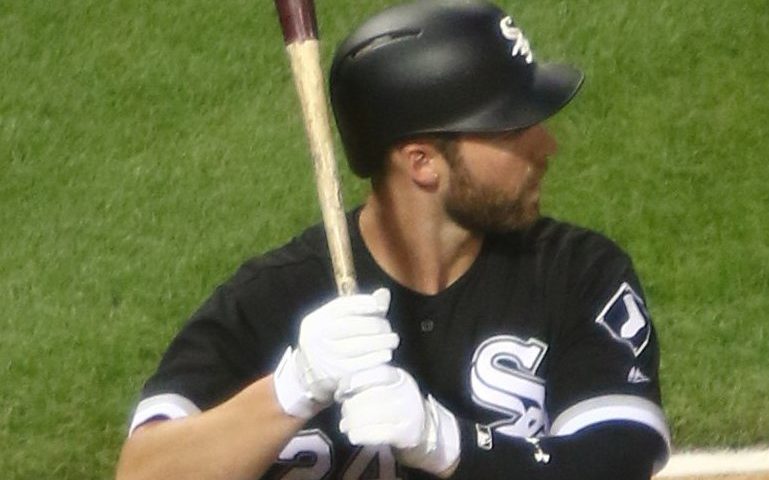The Chicago White Sox are stacked at the minor league level. Having acquired Yoan Moncada, Michael Kopech, Lucas Giolito, and Reynaldo Lopez prior to 2017, they added Eloy Jimenez, Dylan Cease, Blake Rutherford, and other marquee prospect names prior to the 2017 trade deadline. The haul resulted in MLBPipeline.com rating their farm system as the best in the sport, according to Dan Hayes at CSN Chicago. Bleacher Report also has the Sox’s farm system at No. 1. Baseball America has Moncada and Jimenez as the No. 1 and No. 5 prospects in the sport, respectively.
Where does Matt Davidson fit in?
Davidson’s Story
Davidson knows what it feels like to be a heralded prospect, first with the Arizona Diamondbacks and later with the White Sox. Picked #35 overall in the 2009 draft, he placed in the Baseball America Top-100 rankings for the next four years:
- Post-2010: #99 overall
- Post-2011: #97 overall
- Post-2012: #88 overall
- Post-2013: #72 overall
But after compiling an anemic .199/.293/.362 line in 2014, Davidson fell off the overall Top-100 list. He managed to stick in the organizational rankings after that year, landing as the White Sox’s #14 prospect, but fell to #30 following a .203/.293/.375 season in 2015. He was not ranked at all entering 2016 or 2017.
Despite the fall, the White Sox entered 2017 with him as their everyday DH and backup third baseman. The team had called him up in 2016 on the strength of a .268/.349/.444 line in Triple-A, but Davidson fractured his foot in his first game. Entering 2017 after the buzz of the organization’s Chris Sale and Adam Eaton trades, Davidson got his chance to prove he could be a part of the White Sox’s rebuilding efforts.
Thus far, he’s not acquitted himself well. In 328 PA prior to Sunday’s game, Davidson has just a 103 wRC+. His poor 38.1% strikeout rate comes with an also-poor 5.2% walk rate. His resulting .242/.287/.500 line reflects his minor-league approach: some power but not much else. And with power on the rise league-wide, hitters like Davidson need something to distinguish themselves from the pack.
He might have one. One aspect of his game should intrigue White Sox fans: useful contact. On a per-plate appearance basis, Davidson’s rate of ‘barreled’ balls ranks alongside some of the game’s premier sluggers. ‘Barreled’ balls are important because their combination of launch angle and hit speed typically results in at least a .500 batting average and 1.500 slugging percentage.
If you don’t walk, a barreled ball is the best possible outcome for a plate appearance. So it makes sense that the list of 2017 barrel rate (barrels per plate appearance) leaders, culled from players with at least 80 plate appearances, doubles as some of the game’s best hitters:
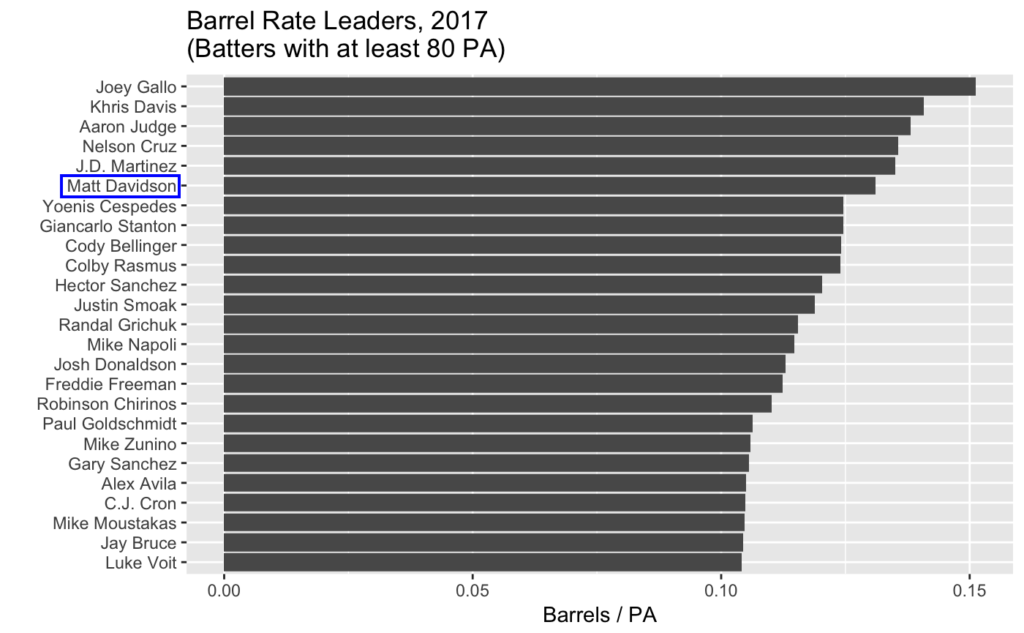
(I computed the rates above using a calculation provided by Bill Petti, which is why this list doesn’t match the official Statcast leaderboard.)
Davidson’s barrel rate of 13.1% places him sixth place this list, surrounded by many luminous names: Yoenis Cespedes, Giancarlo Stanton, Cody Bellinger, J.D. Martinez, Nelson Cruz, and Aaron Judge. These guys repeatedly hit the ball hard and on a line or in the air, leading to positive outcomes.
Finding True Talent
Any stat involves both talent and luck, and rate stats bring the additional complication of different sample sizes. Barrel rate is no different. How much of Davidson’s barrel rate is talent and how much is luck? How certain are we of this distinction? And how can we compare Davidson’s barrel rate to Stanton’s, when Stanton has 546 plate appearances and Davidson has 328?
Bayesian inference provides the answer. This technique regresses rate stats to the mean, accounting for both talent and luck, while essentially equalizing the plate appearances of all players involved. The results enable a fairer comparison between players while also providing a level of uncertainty for each player.
To find Davidson’s true-talent barrel rate I calculated a prior distribution curve of MLB players’ barrel rates using data from 2015 through Saturday, August 26th of this year. This curve looks like the following:
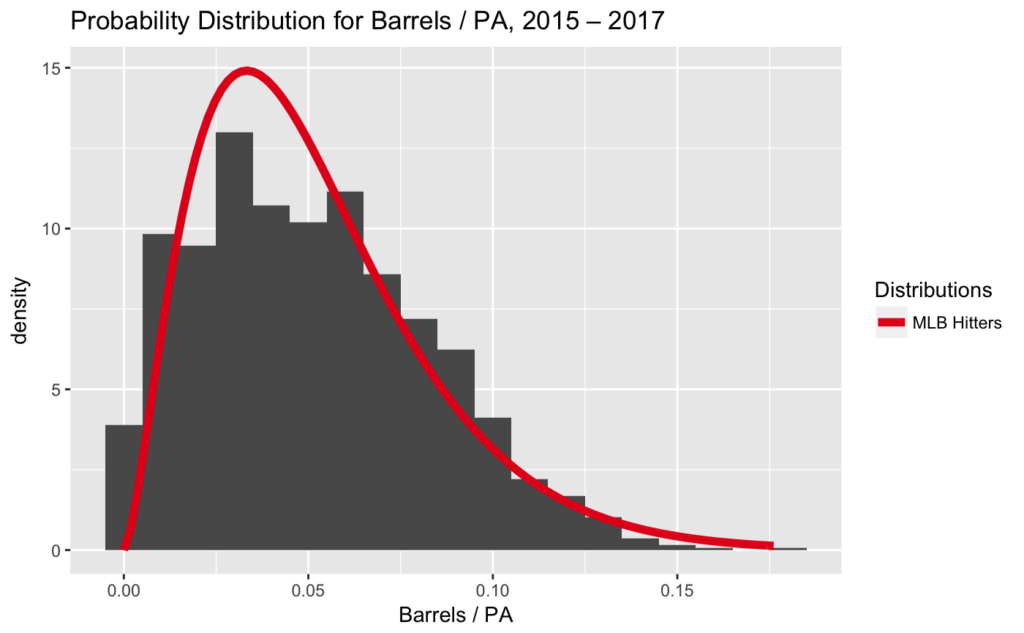
If we knew nothing else about Davidson, we’d guess his barrel rate was about 3%. That’s where the peak in the curve shown above lies. But we do know something else about Davidson. In his 328 PA this year he’s barreled 43 balls, for a rate of 13.1%. That’s quite high; notice the tail of the distribution above ends at about .18. Davidson is exhibiting some serious skill.
Combining the prior curve shown above with Davidson’s 13.1% barrel rate yields the following curve, shown in blue, of where Davidson’s true-talent barrel right might lie:
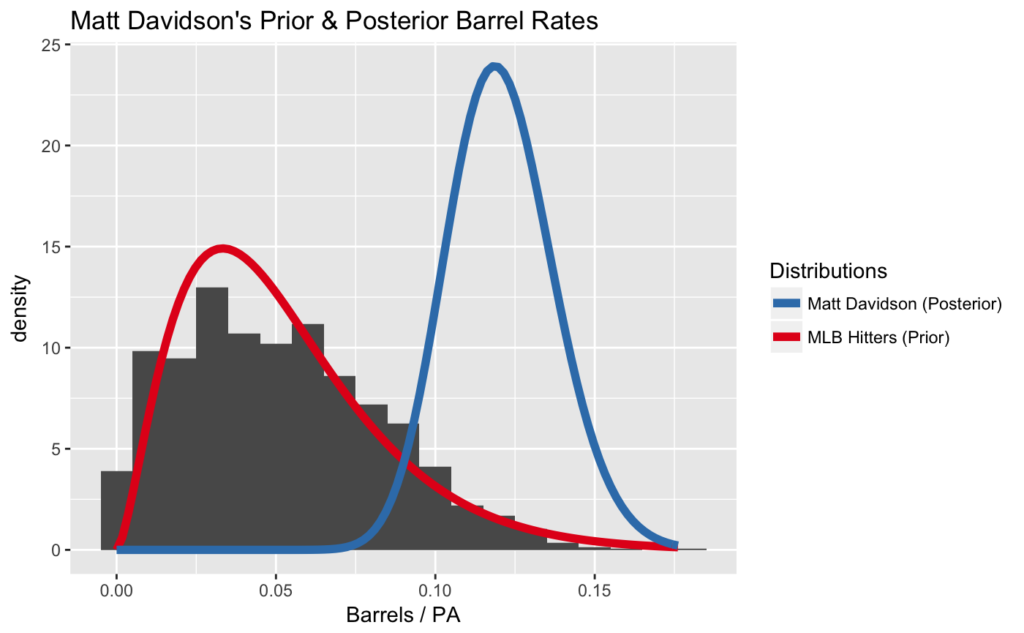
Eyeballing the blue curve, we see Davidson’s barrel rate probability peaks at about .12. We can simulate 10,000 seasons and find the most commonly occurring barrel rate:
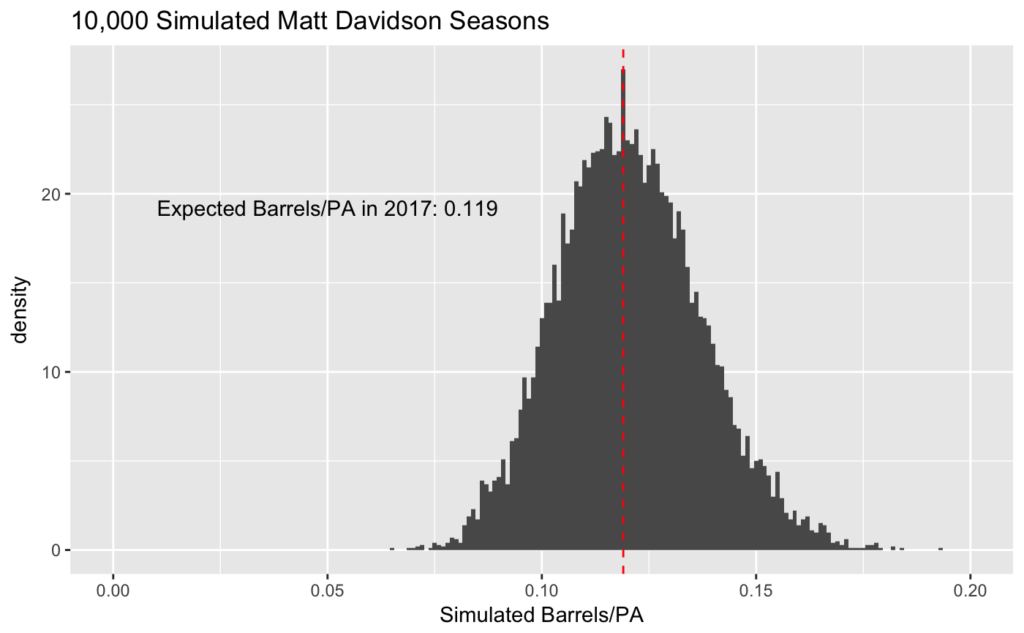
Right now we should expect 11.9% of Davidson’s plate appearances to end in a barreled ball. The 95% credible interval, the interval of barrel rate values inside which we can be 95% certain contains his true barrel rate, ranges from .089 to .154. These values tell us we can be sure that when Davidson hits the ball, he punishes it.
How does this rate compare with his peers? To find out, I calculated the expected barrel rate for all players in the sample, as well as their 95% credible intervals. The following graph shows that Davidson still compares favorably to some of the game’s best:
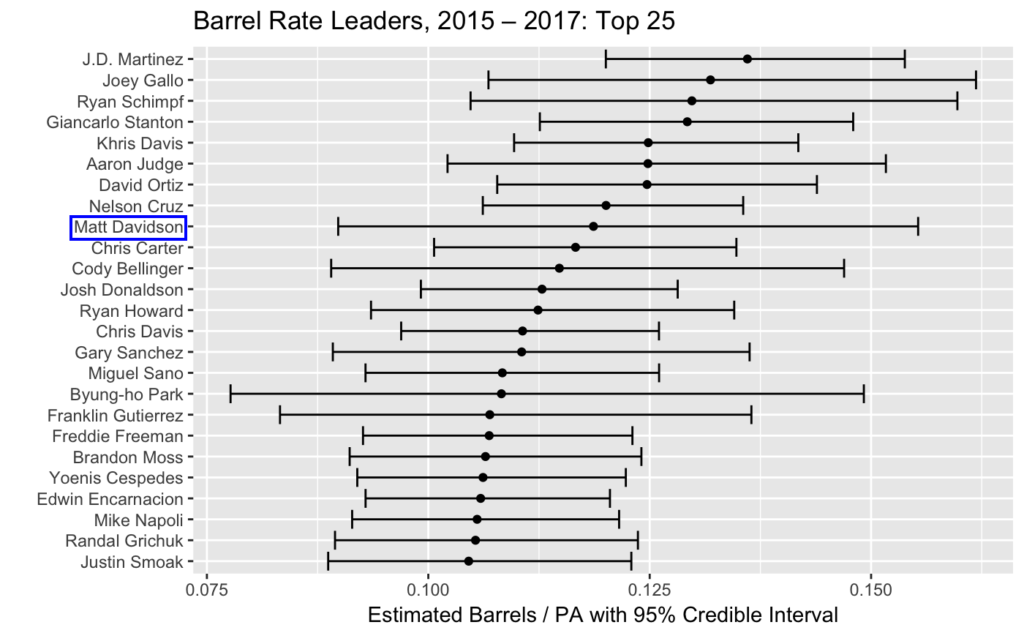
In this graph, the dots are at each player’s expected barrel rate, and the bars indicate each player’s 95% credible interval (the range in which we’re sure their true barrel rate lies). The credible intervals are shorter for guys like Martinez than for guys like Davidson. Why? Because we have 1,537 plate appearances of data for Martinez vs. just 328 for Davidson. So naturally we’re more certain about Martinez’s barrel rate than we are about Davidson’s. Davidson’s credible interval will shrink as we get more information about him, as we watch him play more games and see how the bat comes off his ball.
If you’re an optimist, you might think that Davidson is at the top of the sport when it comes to making solid, run-scoring contact. If you’re a pessimist, you might look at his wide credible interval and conclude “hold on, let’s not get excited just yet! Wait until he has another season or two under his belt before anointing him the savior of the franchise.” Bayesian inference captures both of these opinions much better than other measurements.
Will He Stick Around?
On the list above you see stars like Martinez, Judge, and Stanton. You also see Chris Carter, Ryan Howard, and Byung-ho Park. Not good names. These guys may punish the ball on contact but they don’t make contact that often. Carter’s last trip through the bigs saw him touch the ball just 61.4% of the time he swung. Howard and Park sat at 67.5% and 67.1%, respectively. Davidson currently owns a 65.8% rate.
Chris Davis also appears on the list. Davis was a fringe major leaguer until 2012 when he learned how to walk. Guys like Judge and Joey Gallo also whiff a lot but remain on the field because, despite their flaws, they have walk rates about triple Davidson’s. Judge, Gallo, and Davis also play the field, while Davidson’s played the majority of his game at DH.
Davidson is on the field for two reasons. At 26, he’s much younger than Carter (30), Park (30), Davis (31), or Howard (37). He’s also on a team with no chance of short-term success. The White Sox can afford to play Davidson every day and see what he does. Teams like the Yankees (who jettisoned Carter) or the Twins (who have Park in the minor leagues) are contending and so can’t afford to give plate appearances away.
Is Matt Davidson Chris Carter, or is he Miguel Sano? Is he Ryan Howard, or is he Aaron Judge? Will he be a part of the White Sox’s rebuild, or will he be on the sidelines? Davidson’s wide credible interval leaves all possibilities open. I called his bat ‘intriguing’ because the power-on-contact skills are clearly there. Now comes the hard part: developing and maintaining a good eye at the plate. If Davidson does that, he goes from ‘intriguing’ to ‘exciting’, and the rebuilding White Sox will find a place for him in the years to come.
(Photo by TonyTheTiger)
